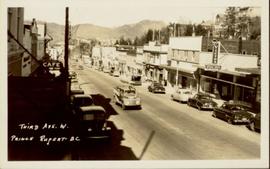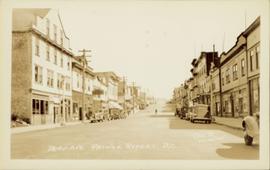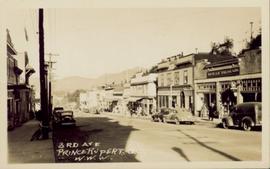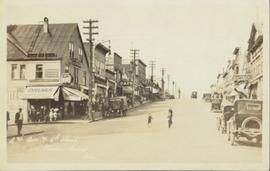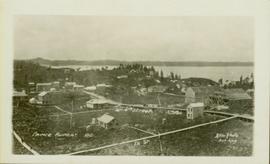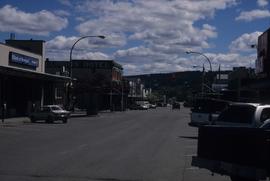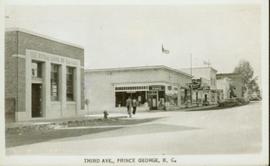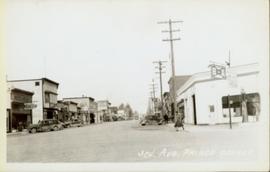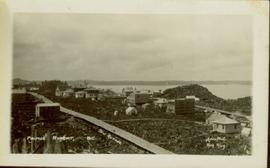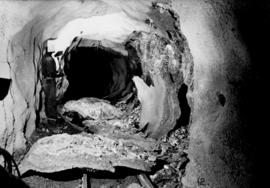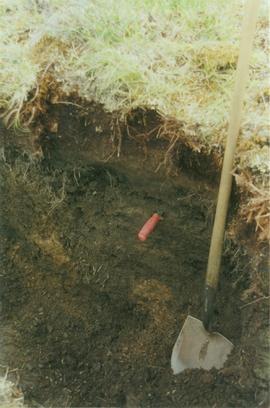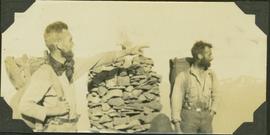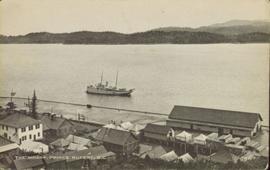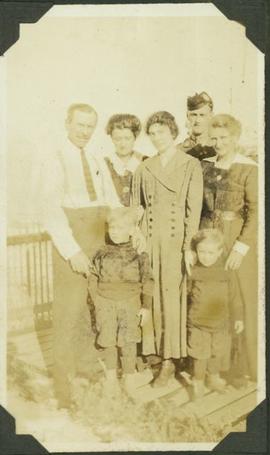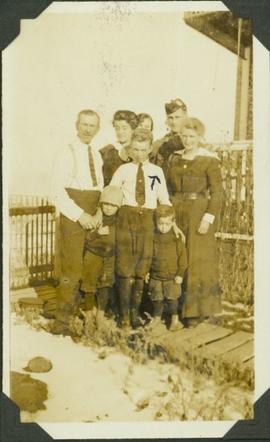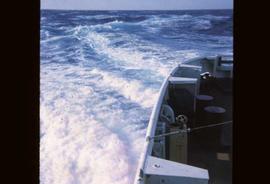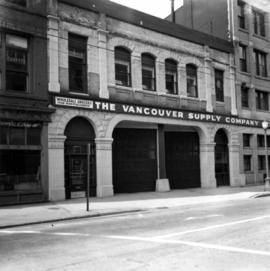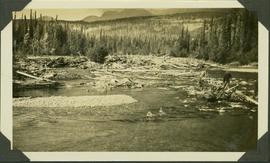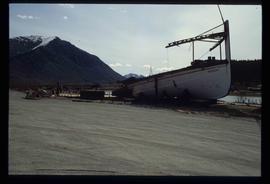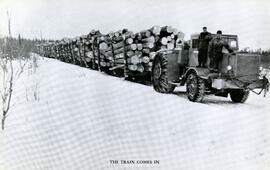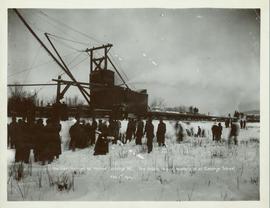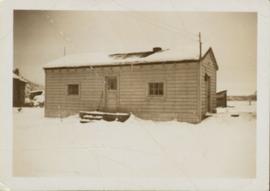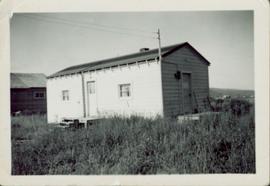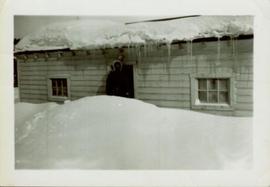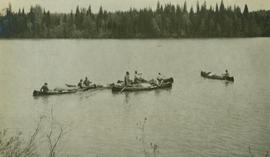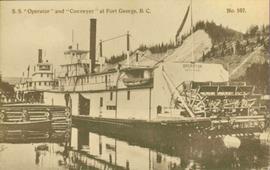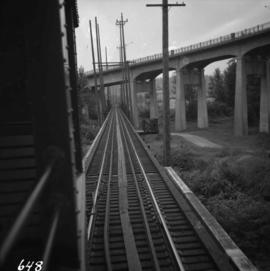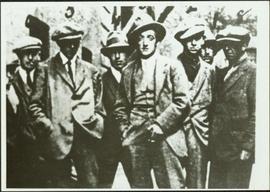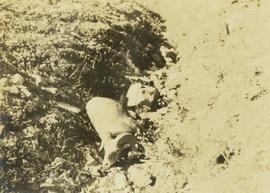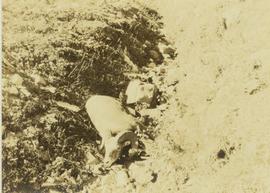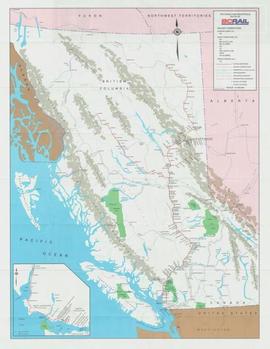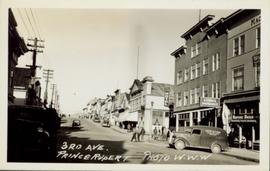Elevated view of Third Avenue in Prince Rupert. What appears to be a firetruck is travelling down the road. Printed annotation on recto reads: "3rd Ave W Prince Rupert BC."
Street view of Third Avenue in Prince Rupert. Printed annotation on recto reads: "Third Ave Prince Rupert B.C. Photo W.W.W."
Street view of several business in Prince Rupert BC. "McRae Bros. Ltd." and "Mussallems Economy Store" are situated on the right side of the street. Printed annotation on recto reads: " 3rd Ave Prince Rupert B.C. W.W.W."
Street view taken from the intersection of Third Avenue and Sixth Street in Prince George BC. A drugstore and several cafes can be seen on the left side of the street. Printed annotation on recto reads: "3rd Ave & 6th Street Prince Rupert BC."
Wide angle photograph showing the intersection of 3rd Avenue and 6th Street, as well as 5th Street in Prince Rupert. Many buildings are visible along the wooden street including a building in mid-construction. Annotation on recto reads: "Prince Rupert, BC. 6th Street 3rd Ave. 5th St Allen Photo Aug 6/09."
Image depicts 3rd Ave in Prince George, B.C. Map coordinates 53°55'01.9"N 122°44'48.7"W
Photo depicts a street perspective of Third Ave., in Prince George, BC, ca. 1950. Handwritten annotation in pen on verso of postcard reads: “You will undoubtedly notice that there are no tall buildings. I don’t think that there is one building in Prince George that is even five stories tall.”
Street level photo of Third Avenue in Prince George. Visible businesses include "Cut Rate Grocery" and "C.N.R. Cafe." Printed annotation on recto reads: "3rd Ave. Prince George."
Wide angle photograph showing 3rd and 2nd Avenue in Prince Rupert. Many buildings, both commercial and residential, and some tents are situated along the wooden roads. Annotation on recto reads: "Prince Rupert, BC. 3rd Avenue 2nd Avenue Allen Photo Aug 6/09."
Item is a photograph of two men standing by a stone cairn, each with packsacks on their backs. One man points while the other man looks in the direction being pointed to.
Photograph of a small vessel on the ocean with a dock and harbour buildings in the foreground. Tents and piles of lumber can be seen among the buildings. Annotation on recto reads: "The Wharf, Prince Rupert, BC. 1657."
Caption: The Weir family, Regina, just after the war. Item is a group photograph of two men, three women and two children identified as the Weir family, standing together on a wooden pathway outside a house.
Caption: The Weir family, Regina, just after the war. Item is a group photograph of two men, three women and two little boys and one older boy all identified as the Weir family, standing together on a wooden pathway outside a house.
Photograph depicts four men in a boat on a lack with a waterfall in the background running through a forest into the lake. Annotation on verso of photograph states: "The water fall + flume for Brown's sawmill Hoscall River BC"
Photograph depicts the building for the Vancouver Supply Company located at 25 Alexander St. in Vancouver, B.C. It is at the center of the old downtown and may have been a former fire hall.
File consists of a contribution to a workshop given by Gary Runka entitled "The Use of Bio-Physical Information - BC Land Commission Overview". Includes excerpts from the Proceedings from the Workshop on Ecological Land Classification in Urban Areas, Canadian Committee on Ecological Land Classification, 23 & 24 Nov. 1976, Toronto.
Commentary on this speech by Barry Smith of the Ministry of Agriculture and Lands:
"Besides a copy of the speech, the package includes + a letter from Ed Wiken of the Canada Committee on Ecological (Bio-Physical) Land Classification to G.G. Runka dated October 1977 and a "Notice of Publication" + 1 copy of the published paper entitled "The Use of Biophysical Information - B.C. Land Commission Overview" by G.G. Runka, Chairman, B.C. Land Commission.
This speech was given to a workshop in Toronto and very closely resembles and reads like a draft of the published (polished) 3 page paper.
GGR remarks that:
"As you can appreciate, we often find ourselves in the centre of politically sensitive issues. For this and other reasons, the Commission might be described as being on the "firing line" with regards to the use of bio-physical information - it is the basis of our agricultural zoning and the basis of our everyday decisions regarding applications under the Act and changes to the Agricultural Land Reserve."
The speech and paper provide an important overview on the role of the Canada Land Inventory (CLI) agricultural capability ratings in the designation of the ALR and is especially important because the paper is written by the individual who was central to both the development of the CLI in B.C. and designation of the ALR.
The published paper forms pages 141 to 143 of the 167 page proceedings of the 1976 workshop."
Image depicts half of a ship, which is named the Tutshi, in Carcross, Y.T.
The item is a photograph depicting a logging truck with fully loaded sleighs of uncut timber in the winter. There are two men standing on the side of the truck. Annotations on the reverse side of the photograph state, "The Pas Lumber Company Ltd. Log Sleigh Train early 1950's Reserve, Saskatchewan."
Annotation on recto of photograph: "The Seel arrives at Prince George BC. The track laying machine is at George Street Feb 1st 1914."
Side perspective of the teacherage located on Brown Ave. in Giscome. Photo taken in November after the first snow. Handwritten annotation in pen on verso reads: “Our House.”
Side perspective of the teacherage located on Brown Ave. in Giscome. Photo taken in September. Handwritten annotation in pen on verso reads: “The Teacherage.”
Bob White, a teacher, standing on the porch of the teacherage after a blizzard.
File contains a 1921 original copy of "The Talking Trees and Canadian Forest Trees" by James Lawler and the Department of the Interior Forestry Branch.
A Journey into the Upper Peace River Country
Stern wheelers “Operator” and “Conveyor” in dock. Printed annotation on recto reads: “S.S. “Operator” and “Conveyer” at Fort George, B.C. No. 107.”
Photograph depicts the split of the Great Northern Railway (GNR) (shown) and the Canadian National Railway (CN) tracks, immediately south of the Fraser crossing at New Westminster.
Photograph depicts a group of seven men standing in front of buildings. This is believed to be a cropped copy print of an original photo of the erroneously entitled the "Cairo Gang." Handwritten annotation on verso of photo reads: “Members of IGOE Gang. These were a group of police spies under the leadership of a fearless R.I.C. officer who were brought in from country posts to identify volunteers who would come in from Command Post in the country to visit H.Q. Dublin.” This annotation may be incorrect; instead, the photograph may depict members of the Special Gang "F" Coy. Auxiliary.
Item is an original "The Spatsizi and Stikine Rivers: Mainstem System Evaluations of Fishery and Recreation Values" by E.J. Osmond-Jones, Environmental Management Division, B.C. Parks Branch. Includes original photographic prints pasted into the report.
Map depicts the route of BC Rail and its connecting rail lines.
File consists of a speech given by Gary Runka entitled "The Rural-Urban Continuum: Tough Land Use Choices Ahead" for the Vernon Rotary Rural-Urban Day.
Commentary on this speech by Barry Smith of the Ministry of Agriculture and Lands:
"This speech / paper does cover some old ground dealt with in other speeches but is nicely brought together here.
GGR outlines several competing land uses and uses agriculture as a starting point in setting the stage by noting that there are just 74,400 food producers and 2,400,000 other British Columbians.
An emphasis is placed on communications, especially since most planners and politicians are overwhelmingly urban oriented. When involved with rural planning it is important to understand the rural side of the fence and look back at the urban area rather than the other way around. This means "understanding the natural characteristics of the land resource and its ecosystems."
Seven issues are considered:
- Short-sighted premises - the supply of land is limitless and the individual has the right to use his
land as he wishes without affecting others; - The interdependence of man within natural systems is not fully appreciated;
- Reluctance of rural people to accept planning programs;
- Institutions and organizations reflect rural reality;
- Sprawl is not confined to urban areas and when it affects the rural area it can be a large problem;
- The dilemma of wanting data to make good land use decisions, but while we wait for information,
bad decision are being made; and - What is politically palatable?
The speech ends with the need for rural and urban communities to be mutually supportive. While farmland preservation isn't central to this speech the rural resource and planning theme is relevant."
Side perspective street view of the Royal Hotel in Prince Rupert BC. The "Ladies [sic] Entrance" sign is visible on the right side of the building. Several vehicles can be seen on the street. Printed annotation on recto reads: " 3rd Ave Prince Rupert Photo W.W.W."
